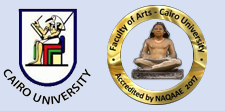Argumentative Strategies in Political Debate Television debate LE PEN / MACRON on 20th of April 2022
عنوان المقال عربي
استراتيجيات الحجج في الخطاب السياسي دراسة تطبيقية على اللقاء التليفزيوني لإيمانويل ماكرون ومارين لوبان بتاريخ 20 أبريل 2022 Stratégies argumentatives dans le débat politique Débat télévisé LE PEN /MACRON le 20 avril 2022
Document Type
Original Study
Subject Area
Language and Literature
Keywords English
Argumentative strategies، ethos، political debates، aim، Persuasion
كلمات مفتاحية عربي
stratégies argumentatives، ethos، Débat politique، visée، Persuasion
Abstract English
The objective of this article is to identify the argumentative strategies used by Marine Le Pen and Emmanuel Macron in their televised debate of April 20th, 2022, few days before the second round of the presidential elections. In this debate, each candidate presents his electoral program, his ideas, and his vision for the future of the country.Our focus is to see what are the argumentative strategies that have succeeded in better positioning their author and have allowed him to build a positive ethical image favoring his victory.We will identify the different elements of the situation of enunciation and try to find out their role in the discursive approach. We will also try to find the pragmatic effects of the strategies employed by the two candidates and see which ones might have brought the author faster to his goal.We will rely on the work of Patrick Charaudeau concerning the enunciation scene (Charaudeau, 2015). We will also use Catherine Kerberat-Orrecchioni’s analysis of political debates; especially that of the previous five-year term of the same candidates (Kerberat-Orrecchioni, 2017). Similarly, we will use the contributions of Ruth Amossy (2010) and Dominique Maingueneau (2014) on the construction of the speaker's ethos and the impact of the speaker's ethical image on interlocutors.
الملخص العربي
تحليل استراتيجيات الحجج أمر لا غنى عنه في الدراسات المتعلقة بالخطاب السياسي من أجل الكشف عن هدف الخطيب.نهدف في هذا البحث تحليل استراتيجيات الحجج التي استخدمها كل من إيمانويل ماكرون ومارين لوبان في لقائهما التليفزيوني في 20 أبريل 2022 قبل عدة أيام من الجولة الثاني للانتخابات الرئاسية.قام كل من المرشحين بعرض برنامجهما الانتخابي لمدة خمس سنوات، وهي الفترة الرئاسية المقبلة. ومن ثم طرحا أفكارهما المختلفة لإدارة البلاد مما أعطى الناخب فرصة للتعرف على اتجاهاتهما السياسية المتضادة.وإشكاليتنا هي معرفة كيف تنجح استراتيجيات الحجج المستخدمة في تفوق مرشح ما على غريمه وتمنحه صورة أفضل في اعين الناخبين وترجح فرصته في الفوز.وسعيا إلى ذلك لاحظنا العناصر المحيطة بالحدث من ترتيبات اللقاء التليفزيوني من حيث تجهيزات المكان، المذيعين، والمتلقين للكشف عن دور كل منهم. حاولنا الكشف عن الاستراتيجيات المستخدمة واستشفاف أثرها على المتلقين.تطرقنا إلى خصوصية الحدث من بناء الحديث، اللغة المستخدمة، واختيار الالفاظ. وذلك من اجل إدراك خطة كل منهما لهدم حجج غريمه والتفوق عليه.اعتمدنا في دراستنا على أعمال باتريك شارودو (2015) في تحليل مسرح الاحداث، وعلى كاترين كربيرا اوروتشيونى في تحليل الخطاب السياسي خاصة أعمالها في تحليل لقاءات ماكرون ولوبان في الانتخابات الرئاسية السابقة (2017).كما لجأنا لأعمال روس أموسى (2002) ودومينيك مانجينو (2014) عند تحليل صورة الخطيب بمستوياتها المختلفة وكيف تؤثر على المتلقي وتساعده في الوصول إلى أهدافه. L’objectif de cet article est de dégager les stratégies argumentatives utilisées par Marine Le Pen et Emmanuel Macron dans leur le débat télévisé du 20avril 2022, quelques jours avant le second tour des élections présidentielles. Dans cette rencontre, chaque candidat présente son programme électoral, ses idées et sa vision pour l'avenir du pays. Notre problématique est de voir quelles sont les stratégies argumentatives qui ont réussi à mieux positionner leur auteur et l'ont permis de construire une image éthique positive favorisant sa victoire.Nous dégagerons les différents éléments de la situation d'’énonciation et essayerons de voir leur rôle dans la démarche discursive du débat. Nous tenterons également de trouver les effets pragmatiques des stratégies argumentatives employées par les deux candidats et voir lesquelles auraient pu approcher l’auteur de sa visée.Comme support théorique, nous nous appuierons sur les travaux de Patrick Charaudeau (2015) concernant la scène d’énonciation. Nous allons exploiter également l’analyse des débats politiques de Catherine Kerberat-Orrecchioni (2017) ; spécialement celle du quinquennat précédent des mêmes candidats. De même, nous aurons recours aux contributions de Ruth Amossy (2002) et de Dominique Maingueneau (2014) sur la construction de l’ethos du locuteur et l’impact de l’image éthique du locuteur sur les interlocuteurs.
Recommended Citation
Labib, Mona
(2024)
"Argumentative Strategies in Political Debate
Television debate LE PEN / MACRON on 20th of April 2022,"
Journal of the Faculty of Arts (JFA): Vol. 84:
Iss.
1, Article 18.
DOI: 10.21608/jarts.2024.244390.1415
Available at:
https://jfa.cu.edu.eg/journal/vol84/iss1/18
Digital Object Identifier (DOI)
10.21608/jarts.2024.244390.1415
Accept Date
2024-01-14
Publication Date
1-1-2024

